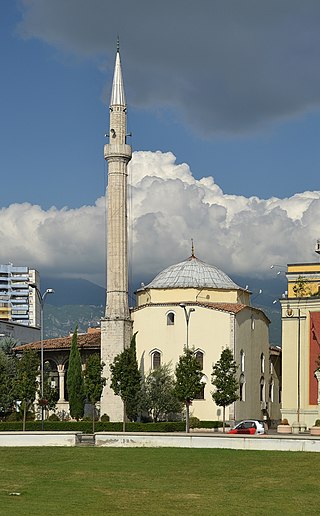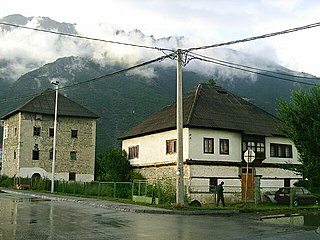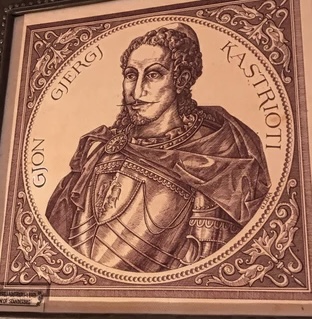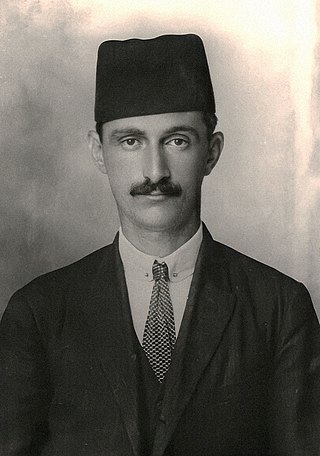
Sulejman Pasha Bargjini was an ethnic Albanian general, nobleman and Governor of the Ottoman Empire. He was originally from Bargjin, but he settled in the village of Mullet, Albania and probably served as a Janissary, he was given the title Pasha. He had fought for the Ottomans against the Safavids in Persia. After that he had built a mosque, a bakery and a hammam. He founded the settlement of Tirana, now the capital of Albania, in 1614 as an oriental-style town of those times. According to some local legends, he named the town he founded after Tehran, the capital of Persia. This, however, is a folk etymology without basis in fact, as Tirana was already mentioned in Venetian documents as early as 1418.

The Et'hem Bey Mosque is a mosque in Tirana, Albania, known for its frescoes outside and inside the portico which depict trees, waterfalls and bridges.

Gusinje is a small town in Montenegro in the northern region. According to the 2011 census, the town has a population of 1,673 and is the administrative center of Gusinje Municipality.
A bejtexhi was a popular bard of the Muslim tradition in Ottoman Albania. The genre of literature created by bejtexhinj in the 18th century prevailed in different cities of what is now Albania, Kosovo, Chameria as well as in religious centers.

The Lead Mosque, also known as the Buşatlı Mehmet Pasha Mosque(Xhamia e Mehmet Bushatit), is a historical mosque in Shkodër, northwestern Albania.

Sulejman Pitarka was an Albanian actor, writer, and playwright. His family moved to Durrës, Albania, when he was five. His brother was Bashkim Pitarka, who became an Albanian diplomat.

The Unknown Soldier is a war memorial statue in Tirana for the soldiers that fell in the struggle against the Italian invaders during Second World War. The statue is located near the Albanian parliament and the Tomb of Kapllan Pasha. It was placed by the Albanian communists: For its construction, the 350-year old Sulejman Pasha Mosque built by the founder of the capital Sulejman Bargjini was destroyed. The sculpture features a soldier with a raised fist and rifle, struggling forward.

The Xhemahallë Complex is a Cultural Monument of Albania, located in Delvinë. The mosque of the complex is thought to be the first "King type" mosque in Albania. Built in 1682, it one of the first mosques built for the local pasha class and is supplied by Llutro's Fountain, a source of water for the mosque itself as well as the adjoining madrasa and Turkish bath.

Gjon II Kastrioti, was an Albanian prince and the son of Gjergj Kastrioti Skanderbeg, the Albanian national hero, and of Donika Kastrioti, daughter of the powerful Albanian prince, Gjergj Arianiti. He was for a short time Lord of Kruja after his father's death, then Duke of San Pietro in Galatina (1485), Count of Soleto, Signore of Monte Sant'Angelo and San Giovanni Rotondo. In 1495, Ferdinand I of Naples gave him the title of the Signore of Gagliano del Capo and Oria. While in his teens, he was forced to leave the country after the death of his father in 1468. He is known also for his role in the Albanian Uprisings of 1481, when, after reaching the Albanian coast from Italy, settling in Himara, he led a rebellion against the Ottomans. In June 1481, he supported forces of Ivan Crnojević to successfully recapture Zeta from the Ottomans. He was unable to re-establish the Kastrioti Principality and liberate Albania from the Ottomans, and he retired in Italy after three years of war in 1484.
Qazim Mulleti (1893–1956) was an Albanian politician, nationalist and mayor of Tirana from 1939 through 1940 and its prefect from 1942 to 1944.

Nicholas II Dukagjini was an Albanian nobleman of the Dukagjini family in the 15th century. He was the son of Pal Dukagjini, one of the founding members of the League of Lezhë. Nicholas Dukagjini fled to Italy after the second Siege of Shkodra in 1479, but is well known for the return to his homeland two years later, together with Skanderbeg’s son Gjon Kastrioti and other noblemen to lead the armed movement against the Ottomans.

Xhemal Bushati (1880–1941) was an Albanian politician of the twentieth century.

Haxhi Et'hem Bey also known as Haxhi Et'hem bey Mollaj (1783–1846) was an Ottoman Albanian administrator, nobleman and bejtexhi.

The Old Mosque or Sulejman Pasha mosque was the founding mosque of the Albanian capital Tirana. The city developed around the mosque, which was founded by the Ottoman Albanian Pasha Sulejman Bargjini along with a hammam and a bakery. In the mid of the 20th century, all of it was razed to make place for the Communist-era Unknown Soldier statue.
Sulejman is the Bosnian and Albanian variant of Suleiman as a given name and surname. It means "man of peace". It may refer to:
Albanians in Syria constitute a community of about 5,000 to 10,000 inhabitants, primarily in the cities of Damascus, Hama, Aleppo and Latakia. Albanians in Syria are known as الأرناؤوط (Arnā’ūṭ).
The Alltuni were a wealthy and powerful Albanian feudal family at a time when the present day territory of Albania was under Ottoman rule. For almost two centuries they ruled over the entire region of Kavajë and large parts of the Myzeqe plains.

Botushë is a village in the municipality of Gjakova, District of Gjakova, southwest Kosovo. It is located near the border with Albania and is part of the Highlands of Gjakova. It is inhabited exclusively by Albanians.
Sulejman Aga Batusha or Sulejman Aga Botusha was a prominent Albanian resistance fighter and revolutionary leader from the Highlands of Gjakova and the wider Gjakova region who participated in the Albanian National Awakening. Born sometime in the 19th century, Sulejman Aga would repeatedly lead Albanian forces against the Ottomans throughout the 19th and 20th centuries, ultimately contributing to the Albanian Declaration of Independence from the Ottoman Empire. He was also a chief of the Gashi tribe and was their head in the Gjakova region.

Notis Botsaris was a Souliote fighter and general in the Greek Revolution of 1821. He was the son of the late Giorgis Botsaris and was the leader of the Souliote fara of the Botsari.














